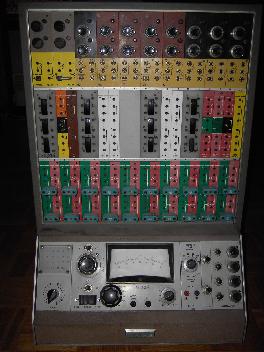| The EAI TR-10 |

|
The EAI TR-10 Analog Computer |
|
|
|
|
The EAI TR-10 is the first and smallest transistorized analog computer built by the famous company EAI (Electronic Associated Inc.) in 1960/1961. It is a proud member of the wellknown PACE family as the photo on the left shows. |
|
|
The two following pictures show some details of the front of the TR-10 analog computer. On the left the upper module rows can be seen. On top are several double potentiometer units, followed by some integrators, multipliers and comparators in the next lower row. The picture on the right shows the bottom most module row containing the double amplifiers with their external feedback resistors (please note that comparable systems like the Telefunken RAT 700 which was introduced in 1960, too, already featured built in resistors, etc.). |
|
|
The following two pictures show the operator control panel - in the picture on the right the balance control potentiometers for the computer amplifiers can be clearly seen at the bottom. |
|
|
The interconnection system of the TR-10 is fairly simple as can be seen below. |
|
|
Below the front panel and the top view of a double amplifier module of the TR-10 can be seen. Please note that each two amplifiers mounted on a single card share a common chopper relay. |
|
|
The following four pictures show two integrator/memory modules. |
|
|
The parabola multiplier (featuring a diode based polygon function generator) of the TR-10 is shown below. Please note the quite high packing density - two printed circuit boards are mounted face to face. |
|
|
The comparators of the TR-10 are half height modules as shown below. |
|
|
The potentiometer circuit is fairly simple - each coefficient potentiometer has an associated switch to facilitate set up of the desired value. |
|
|
Since the potentiometers used in the drawers shown above are simple single turn potentiometers, EAI used a trick to convert them into (more or less) precision potentiometers by employing a gear which translates the angular movement of the knob to a much slower angular movement of the potentiometer's axis. |
|
|
Being an entry level model, the TR-10 does not feature built in computational resistors, etc. So all passive elements have to be added externally to convert the amplifiers into summers, to select the desired summing weights, etc. The pictures below show (from left to right) some feedback resistors which are being used to provide a feedback path from an amplifiers output to its summing junction as well as input resistors used for weighing the various inputs of a summer or an integrator. |
|
|
Documentation: |
|
| 11-JUL-2006, 25-JAN-2007 |